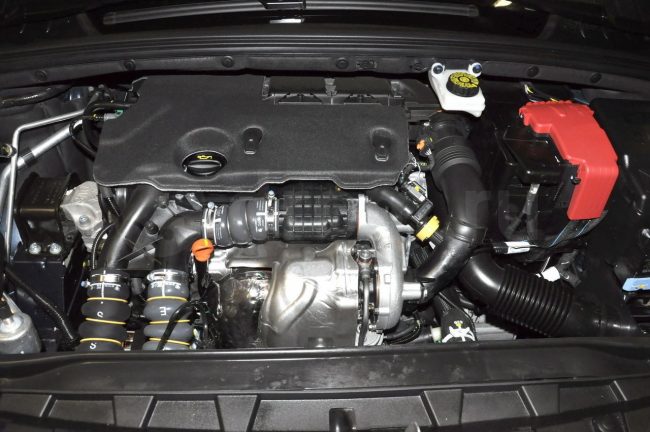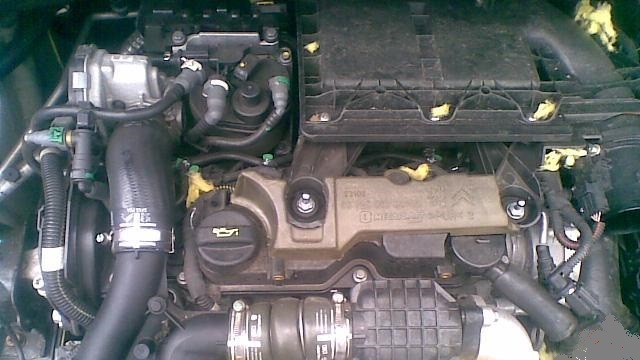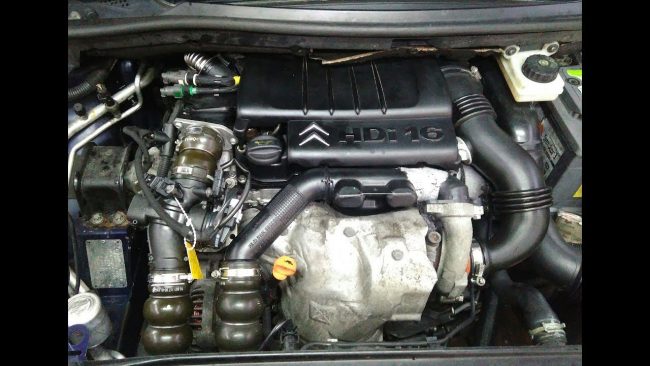
Engines Peugeot 1.6 Hdi
Content
Peugeot launched engines with the designation HDi or High-pressure Direct Injection (direct injection under high pressure) in 1998. Engines with a volume of 1.6 liters appeared only in 2003 and already belonged to the second generation of HDi. Therefore, the manufacturer has already eliminated some of the errors, but not all. Details below.

A bit of history
Peugeot is far from new to the development of diesel engines. They were the first in the world to install a diesel engine in a passenger car. It was an experimental Peugeot Torpedo in 1921. Since then, the company has not stood still. Now Peugeot diesel engines are used by such eminent car brands as Ford, Jaguar, Volvo, Land Rover and Mitsubishi.
Diesel units of the DV family are manufactured at the SMAE (Societe Mecanique Automobile de l'Est) plant in France. The most computerized and technologically advanced plant allows to produce one new engine almost every 20 seconds, with minimal human intervention.
The HDi system is a high-pressure direct injection of fuel into the combustion chamber. This technology improves engine performance, reduces fuel consumption and reduces vibration and noise. In comparison with the "classic" diesel engine, the design of the engine has become more complicated and has not been without weaknesses and expensive parts. With each new generation, the manufacturer makes changes to the design, releases various modifications. Therefore, a series of DV6 diesel engines are installed on many modern cars.
Generations and modifications
Since the manufacturer missed the volume of 1.6 liters in the first generation of the HDi family, the history of the DV6 begins immediately with the second.
The second generation
The first performance of 1.6 HDi was released in 2003. Motors with the designation DV6TED4 and DV6ATED4 were installed on Peugeot / Citroen cars until 2011. And the DV6BTED4 modification was designed for commercial vehicles and was used until 2015 inclusive.
All engines used the Bosch Common Rail fuel system, the resource of which is very dependent on the frequency of replacing the fuel filter. The motor with the DV6TED4 index has two varieties:
- 9HZ - without particulate filter for EURO 3;
- 9HY - version with FAP filter for EURO 4.
The tables below show the main technical characteristics of the Peugeot 1.6 HDi DV6 series engines.
| 1.6 second generation HDI | |||
| Factory index | DV6TED4 | DV6ATED4 | DV6BTED4 |
| Volume | 1560 cm³ | ||
| Fuel system | Common Rail | ||
| Power | 109 hp | 90 hp | 75 hp |
| Torque | 240 Nm | 205 - 215 Nm | 175 - 185 Nm |
| Cylinder block | R4 aluminum | ||
| Block head | 16v aluminum | ||
| Bore | 75 mm | ||
| Piston stroke | 88.3 mm | ||
| Compression ratio | 18.0 | 17.6 – 18.0 | |
| Intercooler | Yes | no | |
| Hydraulic compensators | Yes | ||
| Timing drive | belt and chain | ||
| Phase regulator | no | ||
| Turbocharging | VGT | Yes | |
| Oil volume and type | 3.75 liters 5W-30 | 3.85 liters 5W-30 | 3.8 liters 5W-30 |
| Ecology | Euro 3/4 | EURO 4 | EURO 4 |
| Motor resource * | 240 000 km | 220 000 km | 300 000 km |
*subject to compliance with the maintenance schedule
Third Generation
Motors of this generation have been installed in parallel with the second since 2009. The cylinder head has changed significantly, now it has become an eight-valve. The fuel equipment has also been improved. It can be of two types:
- Bosch - with electromagnetic nozzles;
- Continental (Siemens) - with piezo injectors.
All engines began to be equipped with particulate filters.
| 1.6 HDI third generation | |||
| Factory index | DV6CTED | DV6DTED | DV6ETED |
| Volume | 1560 cm³ | ||
| Fuel system | Common Rail | ||
| Power | 110 - 115 HP | 90 - 92 HP | 75 hp |
| Torque | 270 Nm | 230 Nm | 220 Nm |
| Cylinder block | R4 aluminum | ||
| Block head | 8v aluminum | ||
| Bore | 75 mm | ||
| Piston stroke | 88.3 mm | ||
| Compression ratio | 16.0 | ||
| Intercooler | Yes | no | |
| Hydraulic compensators | Yes | ||
| Timing drive | belt | ||
| Phase regulator | no | ||
| Turbocharging | VGT | Yes | |
| Oil volume and type | 3.85 liters 5W-30 | 3.8 liters 5W-30 | 3.75 liters 5W-30 |
| Ecology | EURO 4/5 | ||
| Motor resource * | 240 000 km | 250 000 km | 300 000 km |
*subject to compliance with the maintenance schedule
The fourth generation
Modern engines that have been installed on new cars since 2014. They differ from the previous ones with an even more complex fuel system and the new Blue HDi technology (exhaust gas aftertreatment system). Thanks to the latter, DV6 diesel engines were able to "squeeze" into the strict environmental standards of EURO 6.
| 1.6 HDI fourth generation | |||
| Factory index | DV6FCTED | DV6FDTED | DV6FETED |
| Volume | 1560 cm³ | ||
| Fuel system | Common Rail | ||
| Power | 120 hp | 100 hp | 75 hp |
| Torque | 300 Nm | 250 Nm | 230 Nm |
| Cylinder block | R4 aluminum | ||
| Block head | 8v aluminum | ||
| Bore | 75 mm | ||
| Piston stroke | 88.3 mm | ||
| Compression ratio | 16.0 | 16.7 | 16.0 |
| Features of the internal combustion engine | the bluehd | ||
| Hydraulic compensators | Yes | ||
| Timing drive | belt | ||
| Phase regulator | no | ||
| Turbocharging | VGT | Yes | |
| Oil volume and type | 4.5 liters 5W-30 | ||
| Ecology | EURO 5/6 | ||
| Motor resource * | 220 000 km | 240 000 km | 250 000 km |
*subject to compliance with the maintenance schedule
Weak and strong points
The overall reliability and service life of the DV6 series units is at a high level. But driving for years without looking under the hood, unfortunately, will not work. In the process of modernization, the manufacturer eliminated some shortcomings, but the complexity of the design brought new ones. Let's look at the weak points of each motor from the series, because knowing about them, you can easily prevent breakdowns. Let's start in order.
DV6TED4
The most powerful of the second generation line, but this does not prevent the engine from being economical. In 2008, even a record was set for the Guinness Book of Records - 3.13 liters of diesel fuel per 100 km, using a Peugeot 308 1.6 HDi.

This version is equipped with a more complex and expensive variable geometry turbine (VGT). It is especially sensitive to low-quality or dirty oil. To extend the "life" of this important part, it is necessary to clean or change the coarse filter mesh more often. It is installed in the fitting of the oil supply pipe to the turbine (this fitting is screwed into the engine block). When the filter becomes clogged, the turbine begins to “starve”, and then its shaft and bearing bushes wear out very quickly.
But the Garrett GT15 turbine has some advantages:
- good traction from the bottom;
- quick response of the turbine, no “turbo lag”;
- Overboost effect - a short-term increase in boost to increase torque by +20 Hm;
- optimal fuel consumption.

The internal combustion engine is picky about the quality of diesel fuel, so in our area there are often problems with the EGR and FAP filter. In 99% of cases, the problem is solved by removing these "extra" spare parts, with flashing the engine control unit.
The DV6TED4 version with the 9HY index (with a particulate filter) has an air metering unit with two dampers. It is often the cause of engine oil leakage. Cracks in the housing or seals cause oil to drip directly onto the alternator and harness. Therefore, you need to fix the problem quickly.
DV6ATED4
It differs from the previous modification by turbocharging. The turbine here is simple, with a bypass valve, manufactured by MHI (Mitsubishi). This affected the power - 90 hp, but potentially reduced service costs. The last statement is controversial, since it largely depends on the regularity and quality of car maintenance.
On this engine, the 9HZ index means the presence of a particulate filter, and 9HV means the absence. The entire range of the second generation 1.6 HDi is equipped with a common rail fuel system with a high pressure pump and electromagnetic injectors.

One of the weak points of the motor is the copper washers under the fuel injectors. They can burn out over time. Then the gases from the combustion chamber will break into the wells of the nozzles and form soot and soot there. The same problem can occur due to the loosening of the injector mounting studs. There is only one way out - replacing the washers and pulling the studs with a torque wrench.
The timing drive in the second generation of DV engines is combined. It consists of a belt and a chain. The chain connects the two camshafts and tends to stretch over time. A clear sign of stretching is a “chirring” from under the valve cover. The factory interval for replacing a belt with a chain is 240 thousand km. But sometimes, due to stretching, you have to cut the time in half.
DV6BTED4
This unit was installed only on commercial Peugeot Partner and Citroen Berlingo. Derated up to 75 forces, the motor is designed for traction loads. Perhaps, due to this, the resource of the DV6BTED4 is higher than that of more powerful variants. A run of 300+ thousand km without "surgical" intervention is quite common.
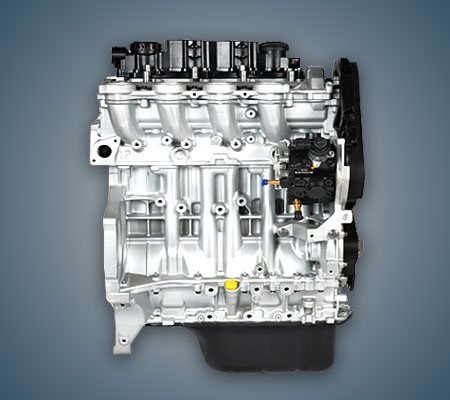
DV6CTED
Representative of the third generation of DV motors. The manufacturer has simplified the cylinder head. Reverted to a simpler, single-cam, eight-valve version. Such a scheme is simpler and more reliable, but there is one drawback - the engine is sluggishly gaining momentum. The French solved this problem by upgrading the piston group:
- new light-alloy pistons - harder and lighter, with internal cooling;
- graphite rings were placed on the "skirt" of the pistons to reduce friction and eliminate temperature "sticking";
- toroidal-spherical combustion chamber - allows more complete combustion of the mixture due to three-dimensional mixing.
The design with one camshaft made it possible to abandon the combined timing system, only a toothed belt remained, without a chain.
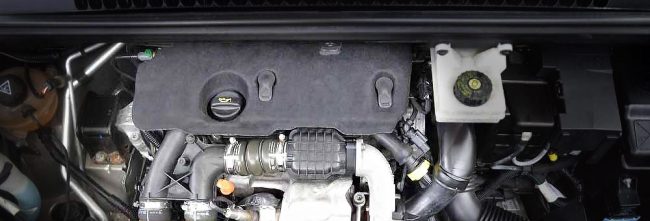
Traditionally, the most powerful version in the DV6C series is equipped with a variable geometry turbine, the rest with a conventional one. The fuel system is now found in two versions. Familiar from the previous generation Bosch with electromagnetic injectors and Siemens (Continental) with piezo injectors. The first option can be repaired and restored, and the piezo injectors will have to be replaced with new ones, from $ 300 apiece.
But the aluminum cylinder block with cast-iron liners is quite maintainable. There are even three repair sizes at quite reasonable prices.
DV6DTED
With an eight-valve head and conventional turbo, the DV6D is potentially a very reliable engine. The power of 90 horsepower may not seem enough, but 240 Hm of torque is enough for normal city driving.
The main problems remain common to the entire family of engines, all kinds of engine oil leaks, burnt nozzle washers and a clogged particulate filter. ICE designated DV6DTED M is a modification that has been reduced in terms of ecology to Euro 4.
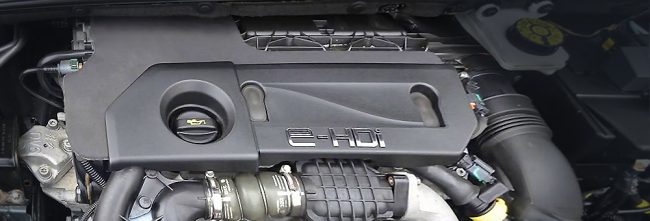
DV6ETED
Traditional in the line derated version for commercial vehicles. The letter "M" at the end of the engine code indicates the absence of a diesel particulate filter. More preferable, in terms of purchase, option - less problems.

DV6FCTED
In the fourth generation, the DV6FC motor has not changed structurally. The main innovation was the introduction of the BlueHDi system. Its main task is to reduce CO2 emissions into the atmosphere. Since September 2015, all Peugeot diesel vehicles are equipped with BlueHDi. This allows them to comply with Euro VI environmental standards, but adds additional complexity to the operation of the car.
For the correct functioning of the system, the special AdBlue liquid must be filled regularly. It loosens the solid particles and allows them to be burned in the diesel particulate filter at a lower temperature. The original liquid is quite expensive (from $ 100 per canister), and a poor-quality replacement can disable the entire system.
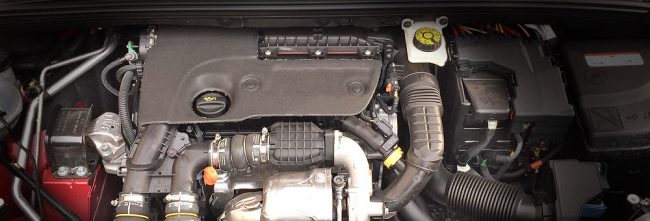
In fact, BlueHDi only affects the environment. But the computer "brain" of the car will not allow you to move normally without fluid or with a malfunctioning BlueHDi system. Errors and warnings will be constantly displayed, the engine may “go” into emergency operation.
On commercial vehicles, the DV6FCTED engine has been derated to 115 hp.
DV6FDTED
Since 2015, it has been installed on almost the entire model range of the French concern. The usual turbine, but the mandatory presence of BlueHDi. Compared to the previous generation, the DV6FD has grown by 10 hp. (100 versus 90), and for "commerce" they reduced it to 95 forces.
In the fourth generation, the oil bath has increased, and now 4,5 liters of 5W30 engine oil are needed for replacement. But improvements to the fuel system made it possible to reduce fuel consumption by an average of 0,5 liters per "hundred".
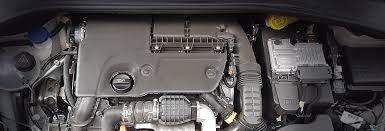
DV6FETED
Even the youngest in the DV6FE line has not escaped the fate of e-HDi, so you will have to add an additive regularly. These motors are available not only for commercial Berlingo and Partner, but also for Peugeot 208/2008 and Citroen C3.
In the new series of engines, the fuel system is installed mainly with expensive piezo injectors. Therefore, potential problems with this node depend on the mileage of the car. Usually, up to 150-200 thousand mileage, there are no problems.
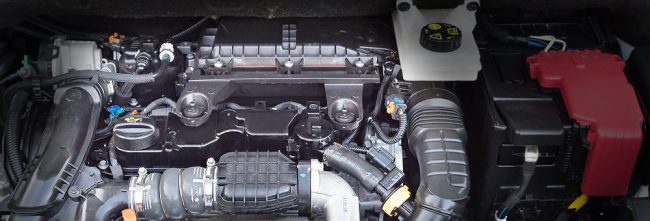
Rare modifications
Some versions of the DV6 motors were modified and installed on a limited range. Below are three examples:
- DV6CM is a simplified version of the DV6CTED engine. They put, for example, on the Peugeot 408 since 2012. The engine was adapted to Russian conditions - the particulate filter was removed due to the quality of local fuel. Since 2017, the power has increased to 114 hp. (it was 112 hp) and the exhaust began to comply with EURO 5 standards, instead of EURO 4.
 DV6CM
DV6CM - DV6DUM - can only be found on the Peugeot Expert minivan since 2007.
 DV6DUM
DV6DUM - DV6UTED4 is a limited modification for Peugeot Partner Tepee from 2012 to 2015. Reinforced to 90 hp motor variant DV6BTED4.
 DV6UTED4
DV6UTED4
Most often, the differences from the main series are minimal and are associated with adaptation to certain markets.
Engine number
The DV6 engine code is stamped on the cylinder block to the right of the generator, an example based on the DV6TED4 motor is shown below in the photo:

When registering, inspectors often require that the site with the engine code be clean.
Service Features
On any modification of the Peugeot 1.6 HDi engine, in order to change the oil filter, you will have to remove the air supply pipe to the turbine. Therefore, after servicing, be sure to check the tightness of the fixing of the nozzle. If there is a "suction" of dirty air, the turbocharger will soon fail. The fuel filter is located at the engine shield - also not the most convenient place to replace it.
If the turbine could not be saved, then when replacing, be sure to follow the following procedures:
- clean or simply throw away the coarse mesh;
- blow/clean the oil heat exchanger;
- remove any coke or carbon deposits in the oil pan and under the valve cover;
- change the oil supply pipe, it is better for the last sample - completely copper;
- change engine oil.
All these procedures are necessary to prevent solid particles from entering the turbine. If “garbage” remains in the engine, then the new turbocharger can work for several hundred kilometers and fail again.
What cars were equipped with DV6 series engines?
The tables show the models of the PSA Peugeot Citroën automaker with reference to a specific engine type and breakdown by year. Motors of the DV6 series are also installed on other brands of machines, but attachments and most parts are not interchangeable.
| 1.6 second generation HDI | |||||
| DV6TED4 | DV6ATED4 | DV6BTED4 | |||
| Make/ model | Years of issue | Make/ model | Years of issue | Make/ model | Years of issue |
| PEUGEOT | |||||
| 206 | 2003 – 2005 | 207 | 2006 – 2010 | Partner I | 2005 – 2008 |
| 207 | 2006 – 2011 | 307 | 2006 – 2008 | Partner II | 2008 – 2015 |
| 307 | 2004 – 2008 | 308 | 2007 – 2010 | ||
| 308 | 2007 – 2011 | Partners | 2003 – 2010 | ||
| 3008 | 2009 – 2011 | ||||
| 5008 | 2009 – 2011 | ||||
| 407 | 2004 – 2011 | ||||
| Partners | 2008 – 2010 | ||||
| CITROEN | |||||
| C2I | 2007 – 2009 | C3I | 2005 – 2009 | Berlingo and | 2008 – 2015 |
| C3I | 2006 – 2009 | C3II | 2009 – 2010 | ||
| C3II | 2009 – 2011 | C4I | 2004 – 2010 | ||
| C4I | 2004 – 2010 | Xsara Picasso | 2006 – 2010 | ||
| C5I | 2004 – 2008 | Berlingo and | 2006 – 2008 | ||
| C5II | 2008 – 2010 | Berlingo II | 2008 – 2010 | ||
| Berlingo | 2008 – 2015 | ||||
| Xsara Picasso | 2004 – 2010 | ||||
| 1.6 HDI third generation | |||||
| DV6CTED | DV6DTED | DV6ETED | |||
| Make/ model | Years of issue | Make/ model | Years of issue | Make/ model | Years of issue |
| PEUGEOT | |||||
| 207 | 2011 – 2012 | 207 | 2010 – 2013 | Partners | 2009 – 2015 |
| 208 | 2012 – 2015 | 208 | 2012 – 2015 | ||
| 2008 | 2013 – 2014 | 2008 | 2013 – 2015 | ||
| 308 | 2011 – 2013 | 301 | 2012 – 2015 | ||
| 3008 | 2011 – 2015 | 308 In | 2010 – 2013 | ||
| 408 | 2010 – 2014 | 308 II | 2013 – 2015 | ||
| 4008 | 2012 – 2017 | Partner II | 2010 – 2015 | ||
| 508 | 2010 – 2012 | ||||
| 5008 | 2011 – 2015 | ||||
| Partners | 2010 – 2015 | ||||
| CITROEN | |||||
| C3 | 2011 – 2013 | C3II | 2010 – 2014 | Berlingo | 2009 – 2015 |
| DS3 | 2010 – 2014 | DS3 | 2010 – 2014 | ||
| C4 | 2010 – 2015 | C4II | 2010 – 2014 | ||
| C4 Picasso | 2011 – 2015 | C4 Picasso | 2013 – 2015 | ||
| C4 Aircross | 2012 – 2017 | C4 Cactus | 2014 – 2015 | ||
| DS4 | 2011 – 2015 | C-Elysee | 2012 – 2016 | ||
| C5 | 2010 – 2015 | Berlingo II | 2010 – 2015 | ||
| DS5 | 2011 – 2015 | ||||
| Berlingo | 2010 – 2015 | ||||
| 1.6 HDI fourth generation | |||||
| DV6FCTED | DV6FDTED | DV6FETED | |||
| Make/ model | Years of issue | Make/ model | Years of issue | Make/ model | Years of issue |
| PEUGEOT | |||||
| 208 | 2015 - p.t. | 208 | 2015 - p.t. | 208 | 2015 - p.t. |
| 308 | 2014 - p.t. | 2008 | 2015 – 2018 | 2008 | 2015 - p.t. |
| 3008 In | 2015 – 2016 | 301 | 2016 - p.t. | Partners | 2015 – 2018 |
| 3008 II | 2016 – 2017 | 308 | 2015 - p.t. | ||
| 5008 In | 2015 – 2017 | 3008 | 2016 - p.t. | ||
| 5008 II | 2017 – 2018 | 5008 | 2017 - p.t. | ||
| Partners | 2015 – 2018 | Partners | 2015 – 2018 | ||
| Traveller | 2016 – 2018 | Traveller | 2016 – 2018 | ||
| CITROEN | |||||
| C3 Aircross | 2017 - p.t. | C3II | 2015 – 2016 | C3II | 2015 – 2016 |
| DS3 | 2014 – 2016 | C3III | 2016 - p.t. | C3III | 2016 - p.t. |
| C4II | 2015 – 2018 | C3 Picasso | 2015 – 2017 | Berlingo II | 2015 – 2018 |
| C4 Picasso | 2015 - p.t. | C3 Aircross | 2017 - p.t. | ||
| Berlingo | 2015 – 2018 | C4II | 2015 – 2018 | ||
| Space tourer | 2016 – 2018 | C4 Picasso | 2015 - p.t. | ||
| C4 Cactus | 2015 - p.t. | ||||
| C-Elysee | 2016 - p.t. | ||||
| Berlingo | 2015 – 2018 | ||||
| Space tourer | 2016 – 2018 | ||||
| DS | |||||
| 3 | 2016 - p.t. | ||||
| 4 | 2015 - p.t. | ||||
| 5 | 2015 - p.t. | ||||
| OPEL | |||||
| Crossland x | 2017 - p.t. | ||||
| Grandland X | 2017 - p.t. |
Сonclusion
Peugeot is at the forefront of technology development for diesel engines. Motors of the DV6 series are indicative in this respect. They have been refined for more than 10 years, while the main indicators are improving without sacrificing reliability. This is especially true for fuel economy. With each new generation, the consumption of diesel fuel is less and less.
Some innovations can not be called very useful, from the point of view of the individual consumer, as is the case with BlueHDi. But do not forget that ecology is not an empty phrase in the global sense. Most of the weaknesses of DV engines are precisely related to the introduction of environmental standards - a particulate filter, EGR, e-HDi. And the durability of the units is highly dependent on the quality of fuel and maintenance.


